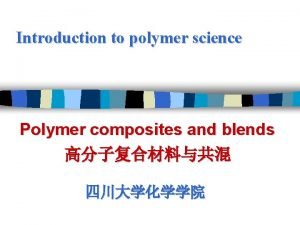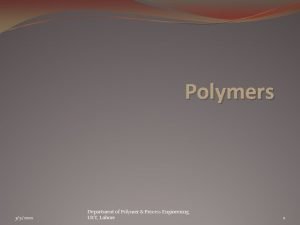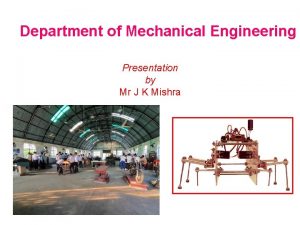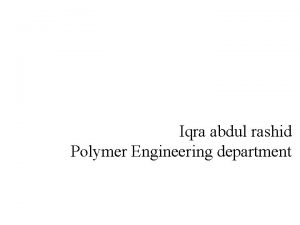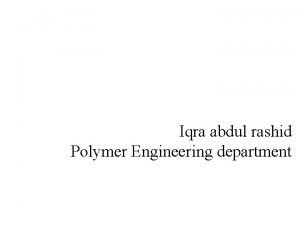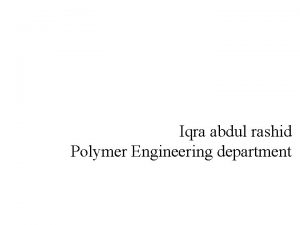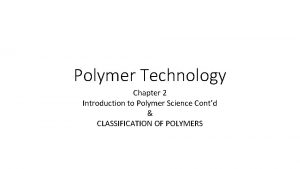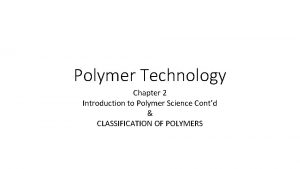Polymer Engineering Chapter 1 Introduction Mechanical Engineering Department















- Slides: 15

Polymer Engineering Chapter 1 Introduction Mechanical Engineering Department, King Saud University, P. O. Box 800, Riyadh 11421, Saudi Arabia ﻗﺴﻢ ﺍﻟﻬﻨﺪﺳﺔ ﺍﻟﻤﻴﻜﺎﻧﻴﻜﻴﺔ

CLASSIFICATION OF MATERIALS Liquid Gas Metals Ceramics Polymers Solid Composites Mechanical Engineering Department, King Saud University, P. O. Box 800, Riyadh 11421, Saudi Arabia ﻗﺴﻢ ﺍﻟﻬﻨﺪﺳﺔ ﺍﻟﻤﻴﻜﺎﻧﻴﻜﻴﺔ

Mechanical Engineering Department, King Saud University, P. O. Box 800, Riyadh 11421, Saudi Arabia ﻗﺴﻢ ﺍﻟﻬﻨﺪﺳﺔ ﺍﻟﻤﻴﻜﺎﻧﻴﻜﻴﺔ

Atoms in metals and their alloys are arranged in a very orderly manner and in comparison to the ceramics and polymers, are relatively dense. With regard to mechanical characteristics, these materials are relatively stiff and strong, yet are ductile, (capable of large amounts of deformation without fracture), and are resistant to fracture, which accounts for their widespread use in structural applications. Mechanical Engineering Department, King Saud University, P. O. Box 800, Riyadh 11421, Saudi Arabia ﻗﺴﻢ ﺍﻟﻬﻨﺪﺳﺔ ﺍﻟﻤﻴﻜﺎﻧﻴﻜﻴﺔ

Mechanical Engineering Department, King Saud University, P. O. Box 800, Riyadh 11421, Saudi Arabia ﻗﺴﻢ ﺍﻟﻬﻨﺪﺳﺔ ﺍﻟﻤﻴﻜﺎﻧﻴﻜﻴﺔ

Mechanical Engineering Department, King Saud University, P. O. Box 800, Riyadh 11421, Saudi Arabia ﻗﺴﻢ ﺍﻟﻬﻨﺪﺳﺔ ﺍﻟﻤﻴﻜﺎﻧﻴﻜﻴﺔ

Polymers include the familiar plastic and rubber materials. Many of them are organic compounds that are chemically based on carbon, hydrogen, and other nonmetallic elements (O, N, and Si). As with metals and ceramics, the properties of polymers are intricately related to the structural elements of the material. Mechanical Engineering Department, King Saud University, P. O. Box 800, Riyadh 11421, Saudi Arabia ﻗﺴﻢ ﺍﻟﻬﻨﺪﺳﺔ ﺍﻟﻤﻴﻜﺎﻧﻴﻜﻴﺔ

Mechanical Engineering Department, King Saud University, P. O. Box 800, Riyadh 11421, Saudi Arabia ﻗﺴﻢ ﺍﻟﻬﻨﺪﺳﺔ ﺍﻟﻤﻴﻜﺎﻧﻴﻜﻴﺔ

Mechanical Engineering Department, King Saud University, P. O. Box 800, Riyadh 11421, Saudi Arabia ﻗﺴﻢ ﺍﻟﻬﻨﺪﺳﺔ ﺍﻟﻤﻴﻜﺎﻧﻴﻜﻴﺔ

Mechanical Engineering Department, King Saud University, P. O. Box 800, Riyadh 11421, Saudi Arabia ﻗﺴﻢ ﺍﻟﻬﻨﺪﺳﺔ ﺍﻟﻤﻴﻜﺎﻧﻴﻜﻴﺔ

Mechanical Engineering Department, King Saud University, P. O. Box 800, Riyadh 11421, Saudi Arabia ﻗﺴﻢ ﺍﻟﻬﻨﺪﺳﺔ ﺍﻟﻤﻴﻜﺎﻧﻴﻜﻴﺔ

Mechanical Engineering Department, King Saud University, P. O. Box 800, Riyadh 11421, Saudi Arabia ﻗﺴﻢ ﺍﻟﻬﻨﺪﺳﺔ ﺍﻟﻤﻴﻜﺎﻧﻴﻜﻴﺔ

Mechanical Engineering Department, King Saud University, P. O. Box 800, Riyadh 11421, Saudi Arabia ﻗﺴﻢ ﺍﻟﻬﻨﺪﺳﺔ ﺍﻟﻤﻴﻜﺎﻧﻴﻜﻴﺔ

Mechanical Engineering Department, King Saud University, P. O. Box 800, Riyadh 11421, Saudi Arabia ﻗﺴﻢ ﺍﻟﻬﻨﺪﺳﺔ ﺍﻟﻤﻴﻜﺎﻧﻴﻜﻴﺔ

1. 1 Introduction and Historical Development A. Development of civilization Stone age → Bronze age → Iron age → Polymer age B. Application of polymeric materials o PE milk bottles o Polyamide bulletproof vests o Polyurethane artificial heart o Fluorinated phosphazene elastomer for arctic environments
 Introduction to polymer blends
Introduction to polymer blends Polymer process engineering
Polymer process engineering What is polymer engineering
What is polymer engineering Actual mechanical advantage vs ideal mechanical advantage
Actual mechanical advantage vs ideal mechanical advantage When using monomer liquid and polymer powder
When using monomer liquid and polymer powder Ytu erasmus
Ytu erasmus Rit mechanical engineering curriculum
Rit mechanical engineering curriculum Nps mechanical engineering
Nps mechanical engineering Adfing
Adfing Specialcourseinfo
Specialcourseinfo Ksu mechanical engineering
Ksu mechanical engineering What is machine
What is machine Statics center
Statics center Mechanical engineering presentation
Mechanical engineering presentation Standard mechanical engineering drawing scales
Standard mechanical engineering drawing scales Hbo level
Hbo level
